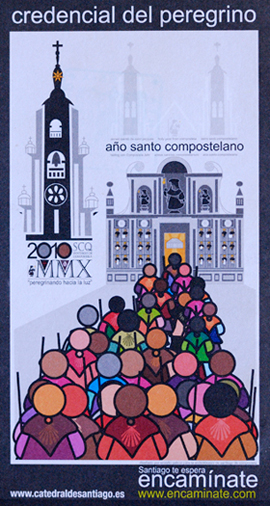Article translated by an automatic translation system. Press here for further information.
Credential
The Pilgrim's Credential - heir of the salvoducts, the credentials cards and the card devised by the Estella Association in the 1960s - germinated at the First International Congress of Friends of the Camino de Santiago held in Jaca in November 1987. The drawing of the cover showing the scallop, cane and pumpkin - which was reprinted in 2011 - was replaced in the Holy Year of 2010 by a colour representing a mass of pilgrims entering the Holy Gate. Credential can be obtained in Associations of Friends of the Camino, Parishes, Bishopric, in some hostels of pilgrims and in the most traditional places of the beginning of the Camino.

Currently there are several valid credential models:
- The official and recommended from the Reception Office to the Pilgrim, processed and printed by the Cathedral of Santiago and sent to the different Parishes, Bishopric and Friends of the Camino de Santiago that request it.
- The credentials provided by some Associations of Friends of the Camino de Santiago, both from outside Spain and our country, which may vary in the design or type of paper.
- The cover letters written and signed by the parish priest. They are an almost disappeared alternative but it is possible to ask a parish priest to write a document sealed with the pilgrimage data, the place of departure, the date and the type of pilgrimage chosen.
- Credential or University Jacobean Accreditation. It is an initiative that in 2002 launched the Association of Alumni of the University of Navarra together with the Spanish universities located on the Camino Francés with the objective of spreading the Camino de Santiago among the university collective at international level. With this credential the pilgrim can also stay in the hostels of the Camino and request in Santiago the traditional Compostela. It is also considered that a pilgrim has completed the Jacobean University Pilgrimage when he has carried out in full, and in this particular case not only the last hundred kilometers, at least the Spanish section of some of the itineraries of the Camino de Santiago. It can be requested by https://www.unav.es/alumni/campusstellae/requested .html and received directly at home. It can also be picked up in the Central Building of the University of Navarra (Pamplona) located in the Camino de Santiago itself as it passes through the University Campus of Pamplona. Once the Camino is completed, if you want to get the Compostela University, it must be sent (by post or email) or delivered personally to the Alumni Office (Central Building, University Campus, 31080 Pamplona. Spain) the original or a photocopy of the Credencial Jacobea Universitaria duly sealed with the stamps of the different universities of the itinerary made (for each itinerary or route Jacobea it is enough to seal in one university per city); at least two stamps per day of passing through the different hostels, parishes, etc. ; the stamp of the university of origin of the university pilgrim and the stamp of the Pilgrim's Office of Santiago de Compostela. It is important to clarify that you do not need to be a university or a former univetarian to request the credential but you do need to obtain the Compostela University. More information can be found at http://www.campus stellae.org
The official credential, printed in cardboard, consists of 14 pages of 16 x 19 centimeters that open as an accordion. It is a print, intended to serve as a cover letter, sealed and filled by a Parish, Cathedral, Bishopric, Association of Friends of the Camino de Santiago, etc. at the beginning of the Camino. In the interior pages are placed the stamps of the hostels, parishes, etc. They certify the pilgrim's passage through that place. Upon arriving in Santiago, in the Pilgrim Reception Office (located in Rúa do Vilar, 1. Telephone: +34 981 56 88 46. E-mail: [email protected]) the date and stamp of the S.A.M.I Cathedral of Santiago is stamped and the Compostela is delivered to those who have performed at least the last 100 kilometers on foot or horse, or 200 on bike.
Necessary credential considerations:
These necessary considerations are listed on the back of the last sheet of the booklet:
- This credential is only for pilgrims on foot, bicycle or horse, who want to make the pilgrimage with a Christian sense, even if only in a search attitude.
- The credential has the objective of identifying the pilgrim, so the institution that presents him must be a Parish, Brotherhood, Association of Friends of the Camino de Santiago, etc.
- Credential does not create rights for the pilgrim. It has two practical purposes:
-
- Allows access to hostels that offer Christian hospitality along the way.
- To request the 'Compostela' in the cathedral of Santiago, which is the certification of having completed the pilgrimage.
"Compostela" is granted only to those who make the pilgrimage with a Christian sense: devotionis affectu, voti vel pietatis causa (motivated by devotion, vote or piety) and only to those who reach the tomb of the Apostle having traveled at least the last 100 kilometers on foot or on horseback, or 200 km on bike.
The pilgrim's credential, therefore, can only be issued by the Church through its own institutions (Bishopric, Parish, Brotherhood, etc.) or authorized (Federation of Associations, Association of Friends of the Camino de Santiago, etc.). Only then can the "Compostela" be awarded in the S. A. M. I. Cathedral of Santiago.
Shelters lack subsidies and should be maintained, within their austerity, with the collaboration of pilgrims (cleaning, care of facilities, ease of rest, financial assistance...).
Groups organized by car or bicycle are requested to seek alternative shelter other than pilgrim shelters.
The credential holder accepts these conditions.